
Historically, companies were required to purchase, assemble, and maintain their entire IT infrastructures in-house. Cloud transformation is changing that.
What is cloud transformation?
Cloud transformation is a process that migrates a company’s current IT infrastructure into the cloud. Digital transformation is driving cloud transformation, as organizations look to become more agile, cut costs, and stay competitive.
Desktops, applications, data, servers, networking, and printing can all be moved to the cloud, which can save enterprises hundreds of thousands, even millions in cost. Cloud solutions will enable an enterprises’ ability to implement innovative practices and to free up money for advanced projects. As lowering the overall TCO is one of the key objectives of Enterprise Architects and CIOs, cloud solutions should be considered in the list of cost-saving endeavors.
CIOs are looking to software-as-a-service (SaaS) to prepare their organizations for the new digital market. SaaS is a software distribution model in which a third-party provider hosts applications and makes them available to consumers over the internet. Due to the web delivery model, SaaS eliminates the need to install and run applications on individual computers.
Benefits of adopting SaaS:
- Accessibility
SaaS applications and processes are stored in the cloud, and are accessible from any computer or any device. - High adoption rate
With online courses, blogs, and webinars, end-users have access to a wealth of information about the application in question. SaaS apps tend to have high adoption rates. See figure 1. Figure 1: Source: Computer Economics, 2017
Figure 1: Source: Computer Economics, 2017 - Lower Costs
SaaS applications are subscription based, which means lower initial set up costs. There will also be lower maintenance costs for hardware, software, office space, and salaries paid to manage a complicated IT landscape. - Easy Upgrades
Updates and upgrades are handled by the SaaS provider - which cuts down on support costs. - Smooth Integration
SaaS providers offer customization opportunities, APIs, and programmable interfaces to fine tune your software to your specific needs.
Despite the benefits, there are certain security implications of adopting SaaS.
Best Practices for Adopting SaaS
1. Stay aware of Total Cost Of Ownership (TCO)
Calculating a fitting TCO for SaaS models can prove to be difficult due to the flexible nature of SaaS. Be sure to identify the various factors that can influence the cost of running SaaS applications, including network traffic, compute capacity, storage, number of users, etc. Identifying and incorporating these factors into your planning gives you a much better idea of your TCO from the outset.
2. Carefully inspect your Service Level Agreement (SLA)
A service level agreement is defined as an official commitment that prevails between a service provider and a client. Particular aspects of the service – quality, availability, responsibilities – are agreed upon between the service provider and the service user. This agreement guarantees a level of security for your software. If the vendor fails to meet these guidelines, the SLA will serve as your legal document for any impending litigation.
3. Be aware of the flexible pricing model
A flexible tool comes with a flexible pricing model. Moving to SaaS means that your monthly charges may vary month to month, depending on usage. Create and reference a monthly usage report for your accounting records.
4. Create clear and consistent SaaS governance
Ensure that all end-users have clear guidelines around who has procurement responsibility for each software. Clear governance ensures that your company receives maximum returns from SaaS endeavors.
5. Consolidate your assets
Consider vendor optimization. If your enterprise is using different services from many different vendors, explore whether you can consolidate them under one vendor. Also, if you have different services from one single provider, integrate them into one contract. This adds simplicity and directly increases your negotiating power.
6. Thorough training
Set aside a portion of the budget for employee training. Guide and train the employees, and set certain guidelines for the software application usage.
With its benefits of flexibility, cost saving, and rapid scalability, SaaS could be the answer to your current IT needs.



